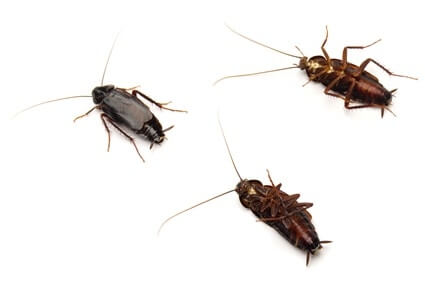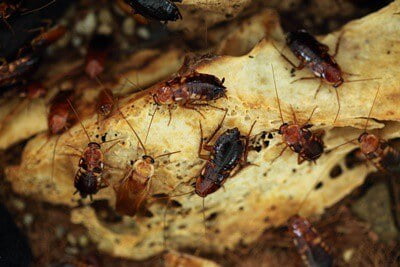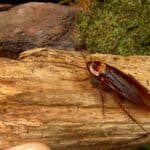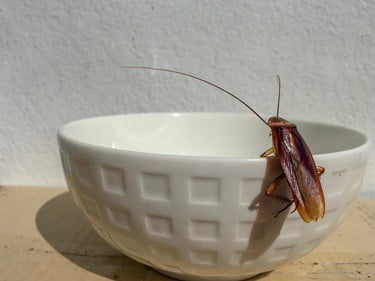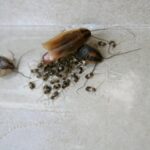Oriental cockroaches (Blatta Orientalis) are a common species that prefer to live in dark and moist spaces. You can find them in basements, floor drains, and sewers. They’re also outdoor scavengers that feed on trash and decaying matter. However, their preference for the outdoors doesn’t stop them from entering your home.
Oriental cockroaches are shiny and dark in color. The females measure at about 32 mm long and are larger than males, which average at 25 mm long. Although they have long wing pads, Oriental cockroaches cannot fly. The wings only shelter the abdominal segments and provide added protection from harm.
Target areas where Oriental cockroaches frequent and remove any egg sacs. Since they like to come indoors during the summer, be sure to block off all entry points. By keeping your home tidy and dry, cockroaches are unlikely to invade your space. Most of all, fix any leaky pipes or faucets, as Oriental cockroaches thrive on moisture.
Oriental Cockroaches Interesting Facts
Oriental cockroaches have many interesting traits. These include:
- They’re mistakenly known as water bugs. That’s because they reside in moist spaces, but water bugs are a different insect altogether
- Crawl more slowly than other species
- Cannot fly, yet they have wing pads
- Their colonies are bigger and more tightly packed than other species
- A female Oriental cockroach can lay up to 200 eggs a year
- Male Oriental cockroaches live for 110 to 160 days, while females live for 35 to 180 days
- Outdoor scavengers
- Use their antennae as sensory devices
- Nocturnal and rarely come out during the day
- Although rare, they can bite humans
- Populations peak in the spring and summer
How to Identify Oriental Cockroaches
Oriental cockroaches can be shiny (although nymphs don’t become shiny until later) dark black or a dark reddish-brown, unlike the traditional brown coloring of other cockroaches. They’re smaller than American cockroaches and larger than German cockroaches. These are their distinguishing characteristics:
What Do Oriental Cockroaches Look Like?
Male and female Oriental cockroaches are oval-shaped with glossy-textured bodies. Their legs feature tiny hairs that act as sensory devices used to detect predators.
Male and female Oriental cockroaches look distinctly different from one another. For example, males are smaller and have shortened ¾ length wings. Their bodies are also more slender in shape. In comparison, females are much larger and broader and appear to be wingless.
Do Oriental Cockroaches Have Wings?
Despite having wings, Oriental cockroaches are unable to fly. Their wings are almost functionless and only serve as shelter for their abdominal segments.
As we mentioned, male oriental cockroaches have wings that cover 75% of their bodies, leaving the last abdominal segment exposed. Females don’t have wings. They have wing pads that protect the first few segments of their bodies.
How Big Are Oriental Cockroaches?
Oriental cockroaches are smaller than other species. On average, the male is about 25 mm long, while the female cockroach is 32 mm long. Females are larger since they lay eggs.
Behavior
Oriental cockroaches are noticeably sluggish and slower than other species. They’re also less fearful and don’t react to looming danger as fast as other species. However, like other cockroaches, they live in groups. They most commonly appear in May, June, and July. Nymphs are active from March through summer, while adults are active during spring.
When female Oriental cockroaches walk, they appear to drag their abdomens on the floor. Males, on the other hand, keep their bodies above ground when they walk.
Habitat
Oriental cockroaches can be found both indoors and outdoors. They prefer living in moist and wet spaces, such as:
- Damp basements
- Dark and moist crawl spaces
- Abandoned cisterns
- Sewers and leaky pipes
- Around garbage bins
- Around toilets
- Floor drains
- Beneath dead leaves and debris
When it’s warm, they’re more commonly found outside in sewers and under old leaves and stones. They’re also found in Asian caves where bats live. During autumn, they’re more likely to move into unheated buildings in groups. They don’t like their environment to be too hot – 20-29 degrees Celsius is their preferred temperature.
They tend to live outdoors. However, they may come into your home during the spring and early summer. The weather outside will be dry and unfavorable for them during these times.
Diet
Oriental cockroaches are outdoor scavengers, feeding on animals, plants, decaying matter, and whatever else they can find. They’re able to eat hard or soft materials and can also consume liquids. However, their favorite foods are anything sugary and starchy. Oriental cockroaches will eat:
- Meats
- Glue
- Leftover food
- Cardboard
- Wood shavings
- Candy
- Starches, including rice or paper
- Gravy and sauces
- Pet food
- Hair
- Skin flakes
When they run out of food, they can invade your home. They’ll make their way through drain pipes and spaces in vents in search of food.
According to a Pennsylvania State University, adult Oriental cockroaches can survive for a month without food. However, they are dependent on water. They cannot survive for much more than 2 weeks without it. If there’s no water, fresh fruits provide essential hydration.
Oriental cockroaches can contaminate food with harmful bacteria, making humans sick.
Are Oriental Cockroaches the Same as Water Bugs?
Oriental cockroaches spend most of their time in moist and wet places. For this reason, many people refer to them as water bugs.
However, Oriental cockroaches are not the same as water bugs. For starters, water bugs are bigger than cockroaches. They measure up to 2 inches long, compared to Oriental cockroaches that are up to 1 inch long.
Likewise, water bugs are hunters, usually picky when it comes to their diet. Meanwhile, Oriental cockroaches are outdoor scavengers that care less about what they eat.
Water bugs usually prey on live insects, while Oriental cockroaches survive on decaying organic matter. Another noticeable difference is in their temperament. While Oriental cockroaches tend to scamper for safety when threatened, water bugs are less fearful. A water bug will bite you.
Most of all, water bugs aren’t considered pests since they mostly prey on other insects and don’t bother entering our homes. Oriental cockroaches are a nuisance since they enter the home and have large populations.
Are Oriental Cockroaches Common?
Oriental cockroaches are among the 4 most common cockroaches that invade most homes. You can find them in:
- Sewers
- Leaf piles
- Flower beds
- Mulch
- Firewood
- Under stoops
Even though Oriental cockroaches are outdoor scavengers, they can find their way into your house when they run out of food or water. They’re more common in wet environments, such as drains and sewers, so they don’t always appear straight away in homes.
Where Do Oriental Cockroaches Come from?
Oriental cockroaches originate from Africa, Asia, and the Black and Caspian Seas. They came to North America during the era of transatlantic trade. Despite originating from Africa and Asia, these pests are widespread in North American homes.
How Do Oriental Cockroaches Travel?
Oriental cockroaches travel into our homes by crawling through sewers, pipes, and drains. They may also hide inside boxes and packages when moving house and find their way into your new home. If they hide underneath woodpiles that you use to fuel a fire, an Oriental cockroach can also get into the home that way.
How Do Oriental Cockroaches Reproduce?
Oriental cockroaches reproduce sexually. Males are direct when it comes to reproducing, while females remain calm. During the mating process, the male raises its wings and secretes a sugar-rich chemical to lure female roaches during mating season (spring and summer). When mating, the male transfers his spermatophore to the female, which she then uses to form and lay her eggs. They position themselves end to end during the copulation process.
Where Do Oriental Cockroaches Breed?
Oriental cockroaches breed in their nests, close to their source of food. After mating, the female cockroach will create an ootheca, where she will lay her eggs. She will then carry this ootheca (egg sac) for around 12 hours to 5 days before depositing it near a sheltered area, close to a food source.
This is because cockroaches do not care for their offspring. The young nymphs have to fend for themselves for the next year after hatching.
How Many Eggs Do Oriental Cockroaches Lay?
A female can produce up to 18 egg sacs (ootheca) in her lifetime. Each capsule contains on average 14 eggs – sometimes 16, which translates to up to 200 eggs or more.
The incubation period of the eggs ranges between 42 to 81 days. However, not all eggs will hatch into nymphs. According to the Virginia Polytechnic Institute and State University, Oriental cockroach eggs require temperatures of between 59-68 degrees Fahrenheit to hatch. After hatching, the nymphs will go through 7 to 10 stages of molting before becoming adults. This takes approximately 12 months.
Oriental Cockroach Information
There is more to these insects than meets the eye. Here’s the rundown on everything you need to know about their habits, smells, and lifespan.
How Long Do Oriental Cockroaches Live?
Adult male Oriental cockroaches live for around 110 to 160 days. Females have potentially shorter lifespans at 35 to 180 days. However, this lifespan depends on several factors, including the availability of food and water.
They can live without food for about a month, but as mentioned earlier, Oriental cockroaches depend on water for survival. They cannot do without it for more than two weeks.
Cockroaches also have natural predators. Hedgehogs, birds, geckos, lizards, rats, and frogs are just a few of the animals that feed on these bugs.
What Do Oriental Cockroaches Smell Like?
Oriental cockroaches are smellier than other types. They produce a foul-smelling, musty odor whenever they congregate in large numbers. They use these secretions as a way of communicating with each other and marking their nesting territories.
As single cockroaches, however, they are relatively odorless. You may not notice they’re in your home until they’ve formed a proper colony.
Do Oriental Cockroaches Bite?
It is uncommon for Oriental cockroaches to bite humans. However, these annoying, crawling pests can bite you when they feel threatened. If they do, the bite is usually harmless. In most cases, their mandibles aren’t strong enough to pierce through human skin, but they can pass on harmful pathogens if they break the skin.
Do not expect an Oriental cockroach to bite you during the day. They are nocturnal creatures, meaning they will only nibble on you if there are no other food sources and they come across you while you’re sleeping. This is rare, however, as they recognize that humans pose a threat to their lives.
Do Oriental Cockroaches Make Noise?
Like other cockroach species, Oriental cockroaches are discreet and silent. They do not make any noise when moving or eating. However, they tend to make funny noises when mating.
If you hear shuffling or little exhales from cracks in your walls or basement, then it is highly likely that you are facing a severe Oriental cockroach infestation. The noises get louder when they congregate in large groups.
Are Oriental Cockroaches Attracted to Light?
Oriental cockroaches are not attracted to light. They prefer dark and moist spaces, where they can dwell undisturbed. This explains why the cockroaches always live beneath debris, leaf piles, sewer lines, and abandoned meter boxes. Oriental cockroaches are more vulnerable to predators during the day, so they prefer to come out at night when it’s safer.
Are Oriental Cockroaches Dangerous?
Oriental cockroaches are considered dangerous because they feed on filth and decaying matter. As such, they can carry dangerous viruses and bacteria into your home. They are often associated with causing:
- Salmonella fever
- Dysentery
- E-coli
They can also cause food poisoning when they come into contact with your meals. Similarly, they’re not only drawn to unsanitary homes – even clean houses are at risk from a cockroach infestation. Once they get in, they’re an invasive pest.
Can Oriental Cockroaches Swim?
Oriental cockroaches cannot swim, but they do float on water. Cockroaches can stay submerged in water for close to 40 minutes without drowning. That’s because they have spiracles, which are slots that appear all over their bodies. They open and close, effectively enabling cockroaches to hold their breath. If an Oriental cockroach becomes submerged in water, it will close its spiracles and stay alive.
Can Oriental Cockroaches Climb?
Oriental cockroaches cannot climb vertical walls or smooth surfaces. Their tiny, hairy legs can only support them when climbing rough surfaces. Unlike other cockroaches, they don’t have specialized pads on their feet. As a result, they avoid climbing walls and other vertical surfaces.
Why Are There Oriental Cockroaches in My House?
Unlike other types, Oriental cockroaches take time before they invade your home. They prefer dwelling outdoors rather than living indoors.
However, if your home has favorable conditions, it is just a matter of time before you experience an Oriental cockroach infestation. The following are a few reasons why your residence is infested.
Your Home Is Damp
If you live in flood-prone areas or places that experience high humidity, then your basement and crawl spaces are likely to become damp. Oriental cockroaches live in dark and moist areas, so they will always find a way to get into your house if you do not keep your basement dry.
Leaking Pipes And Fixtures
Oriental cockroaches love water. If your home has broken pipes and leaking fixtures, make sure you fix them right away. If left unattended, the leaking water will make your floors and surfaces damp. This will eventually attract Oriental cockroaches.
Unwashed Dishes And Leftovers
Like any other cockroach species, Oriental cockroaches also feed on starchy crumbs from leftover food. For this reason, never leave your dishes unclean and always store leftover food in containers with tight-fitting lids. The unwashed dishes might have just enough food crumbs to attract Oriental cockroaches into your house.
Overflowing Garbage Bins And Trash Cans
The main diet of an Oriental cockroach is filth and decaying matter. With this in mind, you should avoid overflowing your kitchen waste cans and garbage bins.
Ensure that your garbage bins have tight-fitting lids to keep the trash intact. If you have so much waste to dispose of, consider buying a larger bin or renting a bigger dumpster.
Compost Pile
Oriental cockroaches prefer cooler temperatures, and they love living in undisturbed spaces. A compost pile offers the perfect setting for Oriental cockroaches to thrive. You can find these cockroaches under piles of leaves, wet mulch, flowerbeds, and beneath heaps of organic matter.
What Are the Signs of an Oriental Cockroach Infestation?
Even after invading your home, Oriental cockroaches won’t stay indoors for long. They tend to move in and out frequently at night, making it hard to notice an infestation. Here are three signs to look for:
Egg Sacs
Look for egg sacs or ootheca around the house. Oriental cockroaches lay their eggs on flat surfaces, underneath items, and against walls. The sacs are dark brown in color and are 8 to 10 mm. long. Each can carry between 14 to 16 eggs, and they are common during an infestation.
Cockroach Odor
Oriental cockroaches have a conspicuous musty smell that is easy to notice where large populations are present. They usually discharge this concentrated smell as a way of communicating with each other. They also use the smell to mark their nesting territory.
Sightings
Oriental cockroaches rarely roam during the day since they are nocturnal creatures. However, during summer, you may see them crawling around as they search for food and water. Summer is usually drier than other seasons, so they are likely to enter your home to escape the heat.
How Do You Get Rid of Oriental Cockroaches?
Treating an Oriental cockroach infestation may be harder than you’d think. There is no one-time treatment. Getting rid of a colony is an ongoing process that requires patience. Here are some tips to get you started.
Inspect Your Home For Cockroaches
Conduct a thorough home inspection to identify problem areas. This will make it easier for you to keep your home cockroach-free. Start by inspecting dark and moist areas, such as:
- Behind the refrigerator
- Under the sink
- Around meter boxes
- Near sewer lines
- Beneath leaf piles
- In overgrown flowerbeds
- Inside electricals, such as microwaves and coffee machines
Use Hydroprene Insecticides
Consider using insecticides containing hydroprene to disrupt the larval development of Oriental cockroaches.
According to Medical And Veterinary Entomology, using hydroprene insecticide suppresses the development and reproduction of Oriental cockroaches. The study shows that exposed females will exhibit deformities and be unable to lay eggs.
Utilize Bait And Granule Stations
Using bait stations is one of the most effective ways of getting rid of Oriental cockroaches. These stations contain food and water mixed with cockroach-killing insecticide.
You can also use these baits in combination with sprays for better results. Lace your bait stations next to places you suspect Oriental cockroaches to reside, such as under the sink or near sewer lines. Once a cockroach eats the bait, it will go back to the colony before succumbing to the poison. Cockroaches eat dead roaches, so they’ll also die.
Use Residual Sprays For Basements And Perimeter Walls
Spray insecticides, such as Raid, are a faster means of pest control. You can use residual sprays virtually anywhere, from basements to perimeter walls. You can also spray directly into walls and crevices or along baseboards, window frames, and door frames.
Apply Dust Insecticide Behind Wall Outlets And Underneath Baseboards
Dust insecticides are more effective. That’s especially true when dealing with Oriental cockroaches that hide inside cracks, crevices, and other hard-to-reach areas. Spread the dust generously:
- Behind wall outlets
- In cupboards
- In cabinets
- Beneath baseboards
- Underneath appliances
Treated cockroaches can also transfer the dust to their shelters. This can help you target the full colony.
How to Keep Oriental Cockroaches Out
Prevention is always the best way to keep Oriental cockroaches out of your home. Here are a few tips to get started:
Prevent Clutter And Keep Storage Areas Clean
Keeping your home clean and dry is crucial to preventing a cockroach infestation. Since Oriental cockroaches love moist areas, you should make sure floors and surfaces are dry and clutter-free. Your lawn should also be clutter-free, so remove damp mulch, wet leaves, and soaked debris.
Store Food And Garbage In Tightly Sealed Containers
Oriental cockroaches feed on starchy food crumbs, filth, and decaying matter. To avoid an indoor infestation, store any leftover food in tightly sealed containers. Moreover, your kitchen waste and garbage should be in containers with tight-fitting lids.
Fix Leaky Sinks, Drains, And Pipes
Oriental cockroaches cannot survive for more than two weeks without water. To avoid a pest invasion, you should fix broken pipes, faucets, drains, and sinks at the earliest opportunity.
Seal Open Vents, Cracks, And Holes Around The Home
You can also keep Oriental cockroaches at bay through exclusion. Seal all open vents, cracks, holes, and other entry points around the home with caulking.
Inspect your basement area and crawl spaces for cracks and holes, and then cover them accordingly. Make sure the weather-stripping around doors and windows is in good condition.
Clean The Dishes Promptly And Vacuum Your Floors Regularly
Avoid leaving unwashed dishes in the sink or dishwasher. Be sure to clean your floors and countertops promptly in case of spills. Also, vacuum your rugs and carpets regularly, especially in damp areas such as bathrooms and washrooms, to remove eggs and decimate nymphs.
Should I Be Worried About Oriental Cockroaches?
Oriental cockroaches are not the most threatening species. After all, they spend most of their time outdoors, scavenging for food around your garbage bins and lawn.
However, don’t throw caution to the wind. Oriental cockroaches can still invade your home, especially during spring and early summer, when finding food outdoors is hard for them.
They can also infest your home if you leave it wet and damp with starchy food crumbs all over the place. To avoid the possibility of an invasion, keep your home clean and dry.
